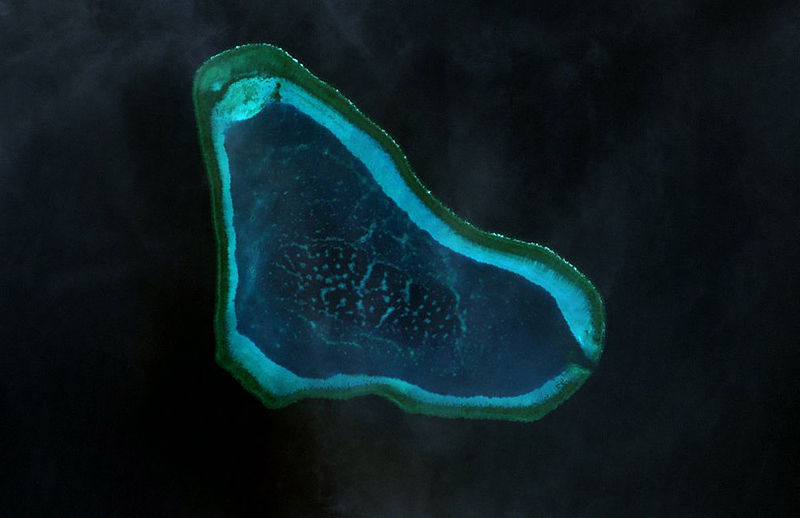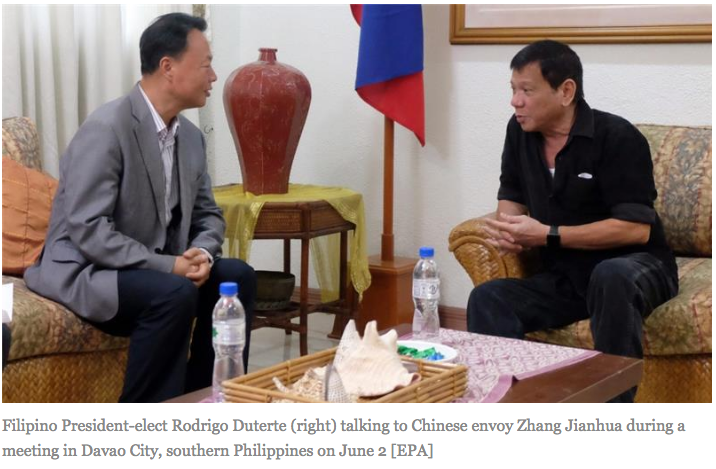Publications
The Scarborough Vivendi
- Details
- Written by: Atty. Jay L. Batongbacal

Photo from: IMOA.ph
The restoration of Filipino fishers' access to Bajo de Masinloc (Scarborough Shoal) is a direct result of PRRD's high-profile pivot to China. News reports over the past few days indicate that Filipino fishers have been able to fish unmolested both around and inside the shoal itself, despite continued presence of China Coast Guard vessels in the immediate vicinity. Recent satellite imagery released by the Asian Maritime Transparency Initiative reveal that the CCG continues to hold station at the mouth of the main entrance to the shoal’s lagoon, while Philippine boats hover at the shoal’s perimeter. AMTI suggests that the CCG continues to block entry into the shoal; however, it should be kept in mind that an obstacle at the shoal’s entrance affects only larger vessels with deeper draught (the depth of a floating vessel’s bottom). Philippine traditional wooden bancas that are smaller and lighter could conceivably enter the shoal at any point along the perimeter under the right tidal and sea conditions, as long as they can find an appropriate opening in the reef structure. Satellite imagery is also literally a mere snapshot of a single moment in time; fishing boats might have merely been anchored to await more favorable time and sea conditions for fishing. The latest reports from Zambales and Pangasinan also indicate that at least some fishermen have actually been able to re-enter the lagoon itself.
Of Claims And Freedoms: Diverging Perspectives On The South China Sea
- Details
- Written by: Lucio B. Pitlo III
Power differentials between states affect how they view and respond to the South China Sea disputes. Small powers largely see them as a clash of unilateral territorial and maritime claims over all or part of the semi-enclosed sea, whereas big powers frame them in a more strategic manner – a contest for control over a critical international waterway. Small powers focus on immediate and direct concerns like resource access, whereas big powers stress universal freedoms of navigation and overflight. Lumping claims and freedoms together muddles and complicates the resolution of South China Sea disputes. Disaggregating them, however, may allow for opportunities to tackle part of the dispute separately.
Distinguishing between claims and freedoms narrows the determination of relevant parties and policy priorities. From a claims vantage point, Brunei, China, Taiwan, the Philippines, Vietnam, and Malaysia constitute the competing parties in the South China Sea, with Indonesia downplaying its involvement in the dispute despite a portion of the Natuna Islands’ waters falling within China’s expansive nine-dash line claim. From a freedoms standpoint, states which rely on unimpeded access to the South China Sea for their energy and trade requirements—such as the United States, Japan, and Australia—also figure as players in the contest.
Arbitration Over, Time for China to Lead Responsibly
- Details
- Written by: Aileen S.P. Baviera
Aileen S.P. Baviera

Photo: Permanent Court of Arbitration
On July 12, 2016, the arbitral tribunal organized under the UN Convention on the Law of the Sea (UNCLOS ) Annex VII , and registered at the Permanent Court of Arbitration in The Hague, ruled on the complaint brought by the Philippines that China’s actions in the South China Sea had encroached on its maritime rights. The tribunal ruled largely in favor of Manila.
In a decision that was proclaimed “final and binding,” it concluded that China’s nine-dashed line claim had no basis in law or historical fact, and that the features occupied by China and Taiwan were not legally “islands” and are therefore not entitled to large maritime zones of their own. This ruling significantly reduces the area under dispute to small features and narrow belts of water immediately surrounding those features.
Post-Arbitration Talks May Hold Key To Regional Stability
- Details
- Written by: Lucio Blanco Pitlo III

Photo from: http://goo.gl/PQt6nV
Dialogue between Philippines and China may hold the key to soothing tensions and promoting peace in a longstanding regional flashpoint. Emotions ran high after the Hague-based Permanent Court of Arbitration (PCA) rendered a historic decision ending a 3-year arbitration process marred by China’s non-participation and artificial island-building and US challenges to excessive Chinese claims through freedom of navigation operations. The Award was considered a milestone in reiterating that pre-existing rights or historical claims are already superseded by UNCLOS and that features that do not qualify as true islands are ineligible for extensive maritime entitlements, save for a maximum12 nautical mile territorial sea for rocks. With a favorable ruling, there is much pressure on the Philippine government to use this legal and moral high ground to put to rest the decades-old dispute, but political realities make this difficult. There is also an emerging view that, despite the enormous resources invested in the legal track, dialogue may still hold the key to resolving the disputes.
